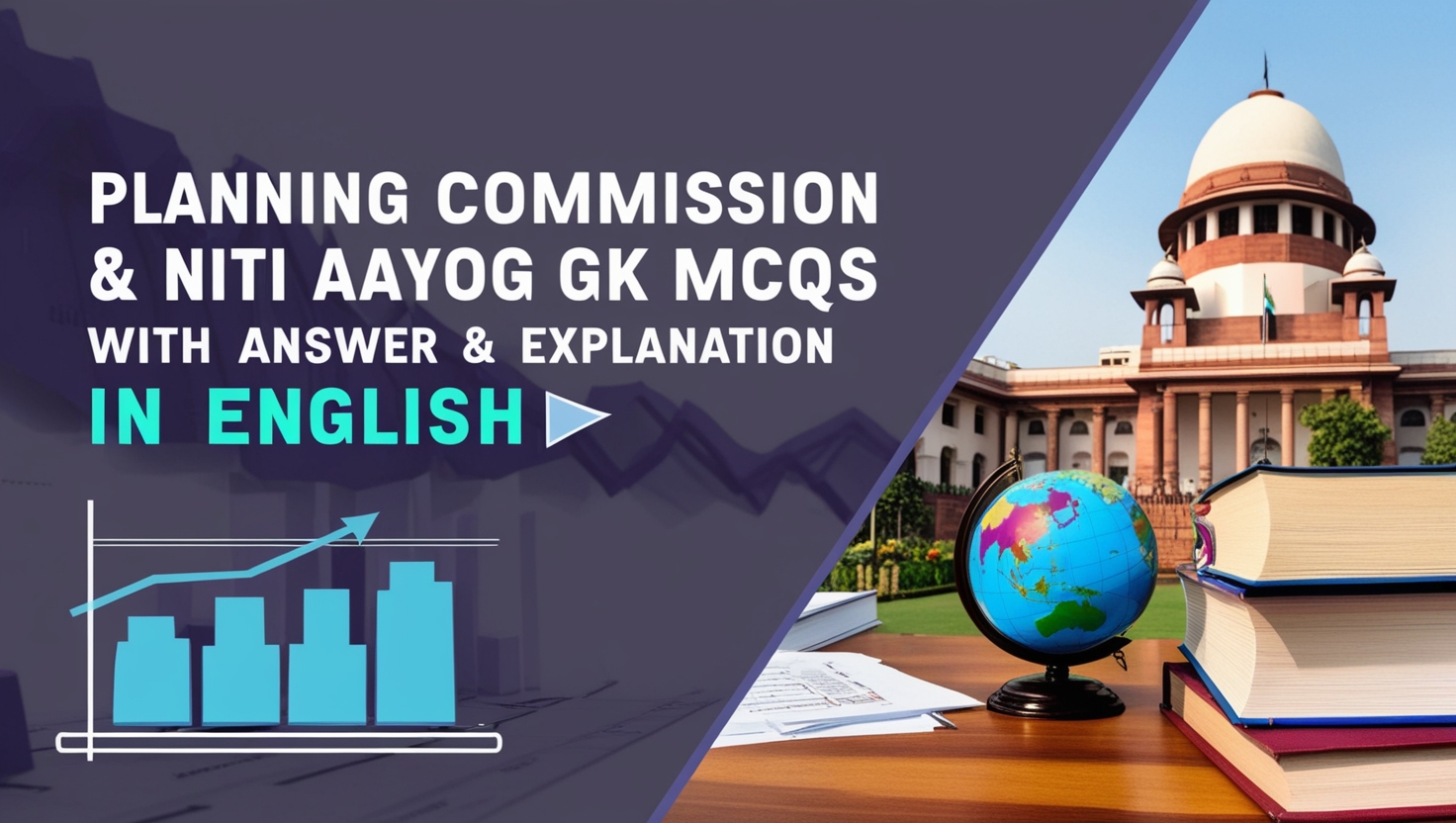
The Planning Commission & NITI Aayog have played crucial roles in shaping India’s development policies. This article, Planning Commission & NITI Aayog GK MCQs With Answer & Explanation in English, is designed to test and enhance your knowledge about these important institutions.
Through a series of multiple-choice questions, you’ll gain insights into their objectives, functions, and key contributions, along with detailed explanations to solidify your understanding. Perfect for competitive exam preparation, this guide will help you stay ahead in your general knowledge of India’s planning and policy frameworks.
1. In which year did the Modi Government scrap the Planning Commission of India?
- 2013
- 2014
- 2015
- 2016
Show Answer
Answer: 2014
The Modi Government scrapped the 65-year-old Planning Commission of India on 13th August 2014 and announced that it would be replaced by a new body called NITI Aayog.
2. In which year was the Planning Commission established?
- 1949
- 1950
- 1951
- 1952
Show Answer
Answer: 1950
The Planning Commission of India was established in the year 1950 through an executive resolution of the government of India on the recommendation of the Advisory Planning Board constituted in 1946.
3. Which type of body was the Planning Commission of India?
- Constitutional body
- Extra-constitutional body
- Statutory body
- None of the above
Show Answer
Answer: Extra-constitutional body
The Planning Commission, established in 1950, was an extra-constitutional body, as it was not created by the Indian Constitution. It played a pivotal role in the planning and development of the country but was not a constitutional or statutory entity.
4. The Unique Identification Authority of India was constituted in which year as an attached office under the aegis of Planning Commission?
- 2005
- 2007
- 2009
- 2011
Show Answer
Answer: 2009
The Unique Identification Authority of India (UIDAI) was constituted in January 2009 as an attached office under the Planning Commission. Its primary objective was to issue unique identification numbers, known as Aadhaar, to Indian residents. UIDAI operated under the aegis of the Planning Commission.
5. In which year did NITI Aayog come into being?
- 2014
- 2015
- 2016
- 2017
Show Answer
Answer: 2015
On January 1, 2015, the Government of India replaced the Planning Commission with NITI Aayog (National Institution for Transforming India). NITI Aayog was also established through an executive resolution and was not a constitutional or statutory body.
6. NITI Aayog can be referred to as which type of body?
- Constitutional body
- Statutory body
- Non-statutory body
- None of the above
Show Answer
Answer: Non-statutory body
NITI Aayog, like its predecessor, is an extra-constitutional body. It is neither created by the Indian Constitution nor by an Act of Parliament. It serves as a premier policy “Think Tank” for the Indian government, offering policy guidance and direction.
7. Who is the chairman of NITI Aayog?
- President
- Vice President
- Prime Minister
- Speaker
Show Answer
Answer: Prime Minister
The Prime Minister of India serves as the Chairman of NITI Aayog. The members of NITI Aayog include the Chief Ministers of all states, Chief Ministers of Union Territories with legislatures, Lt. Governors of other Union Territories, special invitees with expertise, and Regional Councils.
8. Which of the following are the members of NITI Aayog?
1. Prime Minister of India
2. Chief Ministers of all the States
3. Chief Ministers of Union Territories with Legislatures
4. Special Invitees like experts, specialists, and practitioners with relevant domain knowledge
Choose the correct option from the codes below:
- Only 1 & 2
- Only 2 & 3
- Only 1 & 4
- 1, 2, 3 & 4
Show Answer
Answer: 1, 2, 3 & 4
The members of NITI Aayog consist of: (1) Prime Minister of India, (2) Chief Ministers of all the States, (2) Chief Ministers of Union Territories with Legislatures, (3) Lt. Governors of other Union Territories, (4) Special Invitees like experts, specialists, and practitioners with relevant domain knowledge, (5) Regional Councils.
9. Which of the following are the specialised wings of NITI Aayog?
1. Agriculture
2. Data Management & Analysis
3.Health
Choose the correct option from the codes below:
- Only 1
- Only 2
- Only 2 & 3
- 1, 2 & 3
Show Answer
Answer: 1, 2 & 3
NITI Aayog operates through various specialized wings, such as the research wing, consultancy wing, and Team India wing. It works closely with both the Central Government and State Governments to facilitate coordination and consultation on policy matters and development initiatives.
10. Which of the following are the guiding principles of NITI Aayog?
1. Antyodaya
2. Exclusion
3. People’s Participation
4. Governance
Choose the correct option from the codes below:
- Only 1 & 2
- Only 2 & 3
- Only 1, 3 & 4
- 1, 2, 3 & 4
Show Answer
Answer: 1, 2, 3 & 4
NITI Aayog is guided by the following principles: (1) Antyodaya, (2) Inclusion, (3) Village, (4) Demographic dividend, (5) People’s Participation, (6) Governance, and (7) Sustainability.







